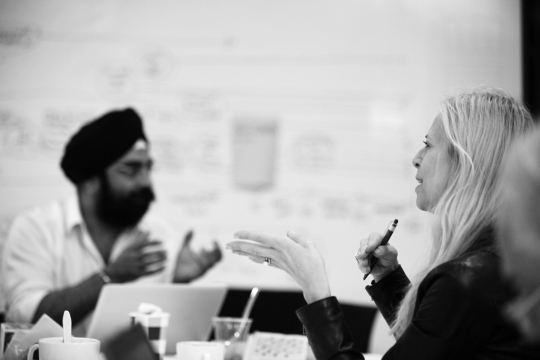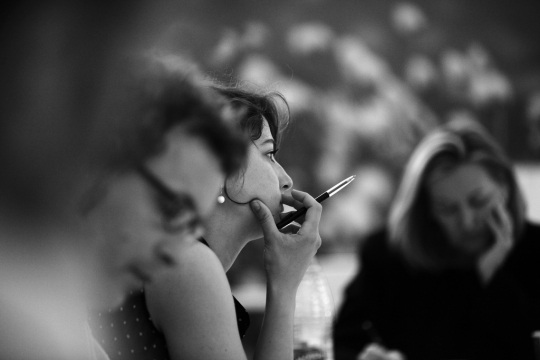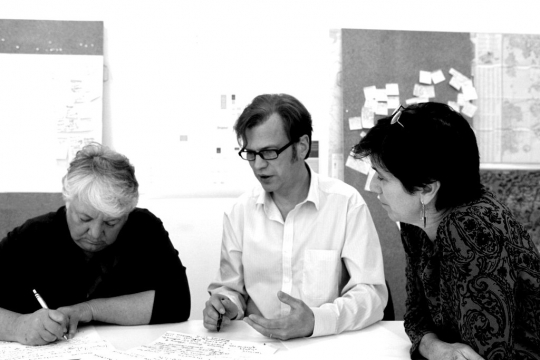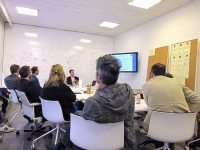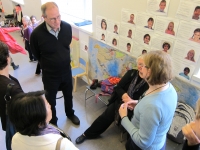All posts by Bryan Boyer
For Yrjö Sotamaa, being able to visualize ideas, think on a global scale, and bind together different kinds of expertise is an inspiring mix of capabilities that design offers to the world. As he mentions, these competencies are just as important today as they were 40 years ago, which is why we're excited about continuing the discussion at HDL Global 2010.
This was the spirit championed at HDL Global 1968, which Yrjö organized with four other colleagues, including Juhani Pallasmaa and Jaakko Ihamuotila. In this video interview, I met with Yrjö at his home outside of Helsinki to discuss the 1968 event, its lasting impact, and the friendships it fostered between people such as Buckminster Fuller, Victor Ppanek, and Marimekko-founder Armi Ratia.
This week at HDL we began doing things labeled "final." Final venue visits, final guests lists, final head counts, final prep meetings. This is appropriate with HDL Global now less than 10 days away.

A morning visit to Säätytalo.
In anticipation of panel discussions which will use the HDL Studios as starting points, we wanted to share some of the outcomes of the Studios... but how do you present something that is in flux, under development? The format we've developed is called the HDL Dossiers. Go check it out—and if you like, you can read below as I share a bit of the thinking behind this format.
A slightly nerdy introduction to the HDL Dossiers
If your process is non-linear, as the design process often is, forcing yourself to use a linear tool is counter productive. Since most blogs and other content management tools are rigidly linear, we needed a new tool to support the work of HDL. We needed a new way to see our work.
The ease of use that a blog allows, as a simple long list of stuff, is great. But its not designed for content that is evolving. We wanted a format that would enable us to evolve a presentation of information and ideas as our understanding develops and changes. One of the important aspects of this is the ability to have control over how bits of information are located. Does A need to sit next to B to make sense? With a normal blog you don't have control over that. The best you can do is to post things in chronological order.

A blog lets you add content to the top of the pile but our Dossiers tool lets us add new stuff while also continually re-shuffling the pile.
We needed the ease of use of a blog, where content is stored in a database and easily manipulated, with the flexibility of a sketchpad, where the presentation is freeform and maleable. And since this is a tool that we intend to use in the daily course of HDL's work, it needs to have a sense of history as well. It needed to be able to keep track of time by allowing versions which the user can then "scrub" back and forth between.

The Sustainability Dossier evolving through time.
The result is something like this. Here's an image of the Sustainability Dossier in two different states. The left shows what it looked like before the studio. In that state we've just assembled the bones of the challenge briefing. But on the right the studio has concluded and their recommendations are starting to filter into the mix. Between the versions some information becomes less important (and thus smaller) or disappears altogether because it's no longer important.
It was a squeeze to get this work done with our already-ambitious HDL Global preparations, but I'm glad we did because we are finally reflecting a bit of work from the Studios. I hope you enjoy digging around the Dossiers and please direct any tips to @HDL2010 or the contact form on this site. We'd love to hear from you.
Leading up to HDL Global 2010 we've been digging into the HDL archives and talking to some of the organizers of the event in the 1960s that has grown up to become part of the Helsinki Design Lab initiative.
Jaakko Ihamuotila spent decades running Neste and Fortum, two of Finland's largest corporations, but as a young student he was one of the organizers, together with Juhani Pallasmaa and three others, of HDL Global 1968.
Jaakko kindly sat with me in his home for this video interview discussing his role as one of the organizers of Teollisuus Ympäristö Tuotesuunnittelu (Helsinki Design Lab Global 1968), and in particular the value of design when exploring new areas of knowledge.
For once I'm getting to the weeknote during the actual week itself. To start, a recap of some new things here in case you missed them.
The first of three interviews is now online. We started off the series with Juhani Pallasmaa recounting his experience at HDL Global 1968. Next week we'll have an interview with Jaakko Ihamuotila and ending with Yrjö Sotomaa the week after that. In the meantime, you can have a look at the Clues to Open Helsinki, a quick project Sitra did with OK Do to get the brain juices flowing in advance of Helsinki's World Design Capital year in 2012. One bit looking backwards and one looking forwards. We like balance.
This week was more of the same with regards to HDL Global: catering, AV, venues, transport, logistics. We've taken to joking about being wedding planners. Government, do you promise to love and care for design, in sickness and in health?
As part of the event we will be hosting conversations around each of the studio themes. This is an opportunity to leverage the work of our HDL Studios to frame a conversation about the globally relevant themes of ageing, education, and sustainability with particular attention to facets where strategic design may have a role. To kick off these sessions we've created video recaps of the three Studios. Those videos will be posted here after they premiere at the event.

Screens from the Sustainability Studio recap video
It feels very good to have these three videos done. Not only was it a significant and hectic effort on the behalf of Seungho and I, but they're also our first foray into using video to explain our work. We've wanted to do this for a long time and the biggest outcome of the past two weeks is a reminder that sometimes you just have to force yourself into new territory rather than waiting for the calendar to magically clear itself up.
If you're doing your first video project while organizing your first major event, why not also throw in the first piece of HDL software? One of the difficulties we've been struggling with since the very start of the challenge briefing work is a way to organize research around fuzzy topics. Most of the research and info gathering we're engaged in comes into focus over a relatively long period of time, and we're often fickle when it comes to categorizing, arranging, weighting, and editing our sources. We like to test out different editorial decisions—arguments, ultimately—quickly and often.

The Dossier tool is still under development
Unable to find the right tool on the market, we decided to build one for internal use. We needed something more accessible than a raw database of content and with the possibility for more articulate relationships than a typical reverse-chronology blog. After experimentation with just about every knowledge management tool we could find, nothing felt right. Instead, we've been working with XOXCO to build the HDL Dossier tool, which is at it's core a 2-dimensional blog. If your average blog is a linear list of diverse content, we've created a place to keep bits of information organized in 2 dimensions, therefore allowing for more specific relationships to be built up between the bits. We'll have some more thoughts on this when it goes live. Next week, hopefully!
So it goes.
From time to time we check in on other Sitra projects such as Low2No and today we're happy to announce something new.
Last November Helsinki edged out Eindhoven to win the status of World Design Capital for 2012. This is a big thing for our small city and it has spurred many conversations about what should, could, might, and hopefully will happen. Everyone here is anxious to have the world come see what design means to Helsinki.
We're especially happy to be helping Helsinki's World Design Capital foundation imagine new roles for design within the public sector and there will surely be more to talk about on that front as our collaboration evolves. But in the meantime...
To get our minds working we teamed up with OK Do for a quick project speculating on the hows that could enable the many good ideas already flowing around town. This became Clues for Open Helsinki: a pack of 17+1 postcards from the near future.
Each card features a nice idea (illustrated by Nene Tsuboi) and a set of speculative suggestions for how the city might use everything at its disposal to enable activity in this area.
We're interested in 2012 becoming the year that structural tools such as laws, taxes, permits, leases, financing, and metrics become part of the global design discourse. In other words, we'd like to see designers more actively involved in—and engaged—by strategic decisions and Clues to Open Helsinki is a small step in that direction.
In addition to being a prolific author, Juhani Pallasmaa is one of Finland's most prominent living architects and he also happens to have been one of the organizers of HDL Global 1968. In this video interview, Marco Steinberg met with Juhani in his home to talk about the state of the world and design's role in the 1960s and 1970s.
As we near HDL Global 2010, it's fascinating to look back at these historical roots and see how things have both changed immensely and stayed the same. Next wednesday have another interview coming up, this time featuring Jaakko Ihamuotila.
If this was any indication of what we can expect for the whole of August, it's going to be a crazy month as we narrow in on HDL Global. Lots of things cooking right now—probably too many.
XOXCO are nearing completion on the HDL Dossiers, a new part of this site which will help us keep track of our focus areas in a new and exciting way. That should launch in another week or two, depending on whether we send them timely feedback or not.
Seungho has been drawing like a madman as he finishes up the artwork for a series of animations that Eetu and I are putting into motion. As I type this, one of nine animation sequences is rendering in the background.
We've also started sending things to press. This week was 14 A-frame signs to be used in our venues. Next week we will be sending badges and other bits. From now until September 1st there are deadlines every few days so it's marathon mode.

Sea Buckthorn berries are tasty
Tomorrow: catering decisions. Have you ever had a Sea Buckthorn Berry? They're delicious, good for you, and plentiful here in Finland. Highly recommended.
Speaking of food, Kigge, Liza, and Adam from INDEX stopped by for lunch while there were in town on other matters. It was nice to catch up and to hear about the Designing for Education student challenge they've just launched.
Everything else is proceeding as usual. The whole team is finally back from summer holidays and things are moving quickly. This week was tiring but good, a formula that we're anticipating a lot of in our near future.
Emil + Stephanie are developing the visual identity for HDL Global 2010 as something that's more dynamic than a logo and less rigid than a system. The approach is to create a mood in the imagery that hints at a broad territory of possibilities as we invite our event guests to explore new territories in leadership, decision-making, and strategic redesign. The material prominently features a photo illustration (seen here if you scroll down) which was created in a frenzied weekend of creativity. It looked something like this:
This kicks off a month of films for HDL. Each wednesday between now and the end of August we'll post a short film. Following this are a series of three interviews with some of the people who organized HDL Global 1968.
Things were already picking up in the Sitra offices this week as people begin to trickle back from summer holidays. We were occupied with a full checkup of our operational plans for September. This was a pragmatic follow up to last week's review of all HDL Global 2010 content.
Over a long lunch Marco and I looked at the calendar week by week through August, and then day by day in the final week leading up to the event. There are a lot of loose ends to tie up in the next month, but it's coming together pretty well.
Meanwhile, the OCR experiment we began last week is coming along. Rory Hyde deserves a kind shout out for his contribution of five pages of OCR work. Would you care to OCR a page or two?
And we also have something nice to look at. This sneak preview of what HDL Global 2010 looks like is from Emil+Stephanie:

On Wednesday we'll also post a very short little film about how this picture came to be.
As the quiet month of July comes to a close, we're savoring these last moments of relative calm. This morning began with a thunderstorm in Helsinki—a sign?
We've been re-working the programme for HDL Global yet again—it's subject to constant tweaks as we fine tune the flow and punctuation. Marco has taken to keeping the programme schedule as a constantly-open document on his computer and from time to time we open that window and twiddle bits around. Should Talk A come before talk B? As we've witnessed while attending other events, getting the order of the day right makes a big difference. Get the sequence wrong and you lose momentum, but if the programme unfolds properly ideas will be humming by the end of the day.

A salmiakki tasting at Emil+Stephanie's office as we curate a welcome pack for our international guests.
Various other bits: on the horn with Eric in San Francisco, Cecilia in Singapore, and Bill in Cambridge, MA; meeting with Emil+Stephanie to review print design work; had a prep meeting with Eetu, who will be helping with some video editing next week; and started thinking through alternative scenarios for all three days of the event. What happens if Person X misses their flight? That sort of thing.
We also began uploading transcripts from HDL Global 1968 to our Flickr account. If you're a fan of Christopher Alexander's work you may enjoy his presentation of "The Organization of Design Pattern." I thought it might be interesting to try an experiment in crowdsourced OCR. I've transcribed the first page of Alexander text, maybe you would like to contribute by OCRing another page?
Last week was supposed to be a slow one, but two meetings fell into place at the last minute and so the HDL team (those of us not enjoying the Finnish summer) was split between Zurich, Moscow, and Helsinki. It was a time for us to focus our thoughts some long term ideas about what HDL is and could be—an exciting thing for us to be thinking through.

A snapshot from our whirlwind trip to Zurich
One of the biggest questions on our minds has been, "what next?" We have a clear idea of where HDL goes, but on a broader sense we're interested—maybe even concerned about—the hype that has been recently poured into the term "design." The danger is that the hype becomes destructive if the design community is not able to deliver. So far, many corners of the business world have been convinced of the importance of designers involved in many different, and more strategic roles, but what about NGOs, cities, or even nations? Although early evidence from that sphere is positive, as one can see in our case studies and elsewhere, the available pool of successes is small.
Which makes us curious: what should HDL do to grow that pool? What's the right role for design within larger organizations? How much design "presence" is necessary, or even wanted? Our own Studios are one proposition, but we're anxious to see more happening, and more quickly.
How will strategic design engagements be funded and by who? If one of the defining factors of truly strategic work is that it cuts holistically across silos, it might always be difficult to find funding. At the end of the day, the majority of the world operates under the cruel logic of the budgetary line item, so how can strategic designers find a place to fit when their work is naturally between the lines?
This is a true design problem in every sense of the word.

Left to right: Inderpaul Johar, Marianne Guldbrandsen, Petri Lehto, Onny Eikhaug, Hannele Seeck, Alberto Holly, Emily Thomas, John Ruark.

Helsinki's Deputy Mayor Paula Kokkonen joins the studio for the friday review.
And many more here on Flickr. Photos by Ivo Corda.

Left to Right: Federico Parolotto, Janne Hukkinen, Katharina Schmidt, Dan Hill, Patricia McCarney, Seppo Junnila, Matthias Rudolph, Alejandro Aravena.

Alejandro presents the Studio's work

Timo Mäkelä, Director of Sustainable Development and Integration at the DG Environment of the European Commission, comments during the Friday review
With more photos on Flickr if you cant get enough. Photos by Ivo Corda.

Left to Right: Roope Mokka, Maja Kecman, Lim Lai Cheng, Juha Teperi, Linda Nathan, Darrel Rhea, Ann McCormick, Jane Bernstein

Timo Lankinen, director general at the Finnish National Board of Education, discussing the Studio's recommendations
More photos from the studio on Flickr. Photos by Ivo Corda.
Summer is in full swing here in Helsinki, which means that things are slow. Well, things are slow everywhere but HDL. Marco and I continue to narrow in on HDL Global, taking advantage of the empty calm of the office to talk through some scenarios without having to slice the conversation into between-meeting-sized chunks.

A temporary fruit orchard built in the heart of London as temporary nursery for plants and trees which will ultimately be gifted to local schools and community groups. Also home to Aalto University's Nest, sponsored by the Finnish Institute.
I started the week in London, where I was visiting the London Festival of Architecture to share some thoughts about design, complexity, and decision making informed by our work here at HDL.
Back in Helsinki we have things on the burner: working with XOXCO on a new part of this website, which will be helpful for sharing the work of the HDL Studios as well as supporting Studio-style work in the future; walking through HDL Global step by step with Emil+Stephanie to make sure that signage and printed material is designed for all of the needs, navigational, informational and otherwise; setting up contracts and schedule for some video work to kick off in early August; on the horn with Zurich to explore a potential new avenue for HDL.
We also put up a ton of images on Flickr. Over the next week we'll trickle some of those photos on the blog, but if you just can't wait to see you can find shots from all of our HDL Studios, most of which are by the talented Ivo Corda.
Posts tagged with "How-To" contain reflections on designing, organizing, and operating the HDL Studios, a series of three collaborative, multi-disciplinary problem solving experiments we held this summer. These posts are meant to be informative for others who may also be exploring ways to put the design process to use in new ways or those who find themselves struggling to work between disciplines or silos.
—
The best way to share ideas depends on the specific ideas and the audience you want to share with. In other words, the mechanisms of knowledge transfer are every bit as much a design project as is the development of whatever knowledge one aspires to share. This post is about some of the techniques we're using to share our work right now.
In the past, printed reports have been one of the dominant tools for sharing new information, be it research, analysis, or evaluation. For a number of reasons, these reports seem almost mandatory—or may even be legally mandated, depending on your organization's status. But what good is a report that no one reads? And how useful is a report that takes so long to produce it's out of date before the ink dries?
At this early stage in the work of Helsinki Design Lab we've taken a different path, which is to focus on conversations rather than reports. The printed (and online) documentation will come—we're beginning to work on them now—but at this stage the emphasis is on bringing people together with enough time, space, and quality input to have a good conversation.
Review
The model we used in the HDL Studios is based on the "final review" concept which is borrowed from design education. In design school, a studio is comprised of 10-15 students working on their own individual response to a project assignment which is issued at the beginning of the semester. There are interim "pin ups" every couple weeks where the whole studio gathers around to look at in-progress work literally pined up on the wall, while the professor critiques, or "crits" for short, the students' projects in terms of what's working and what's not. The culmination of the design school semester is a "final review" where students present their projects to a panel of 4-6 professors who offer a more substantial critique of the work. This discussion is where the ideas of the semester are teased out, compared, and tested.
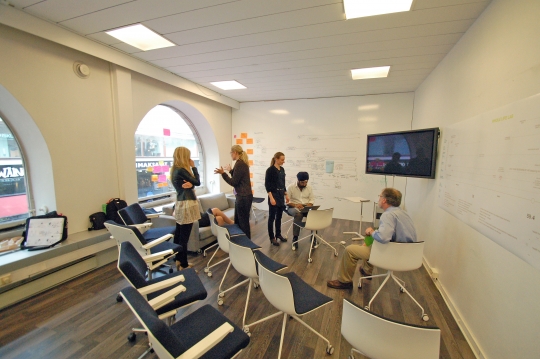
Finishing up slides just before the final review
An HDL Studio works collaboratively on a single holistic proposal and then shares its findings in a final review similar to that discussed above. Months before the studio started we were working to secure a group of 3-5 high level guests from Finland and Brussels who have a vested interest in the theme of the studio. Having the right audience who is both committed to the topic and acutely aware of the nature of the challenge is very important because it makes them good critics, and ultimately good champions.

Indy Johar presents the HDL Studio on Ageing's findings. Photo: Ivo Corda
The studio gives a presentation of 30 minute or less sharing how they define the challenge, what opportunities they see, what barriers they perceive, and then outlines a collection of specific project ideas that coalesce into a "roadmap" towards strategic improvement. This is the synthesized outcome of their week in Finland and it may be accompanied by slides, videos, whiteboard drawings, handouts, or any other medium they see fit to use.
After the presentation concludes, we transition into a conversation. This is a moment where the specific nature of the physical space is very important. For these final reviews we pushed the main work table out of the way so that there's nothing between the person presenting and the audience. Once the formal presentation is over, the presenter can sit down and a conversation among peers flows easily. Would there have been a pedestal, table, or other barrier in between the interaction would be too rigid. Making these transitions seamless is important because they are the points where momentum can easily be lost.

As simple as it sounds, having the chairs in a circle really does yield a more active conversation
The worst thing after a presentation is to leave too little time for conversation, condemning what dialog does happen to be mere platitudes and clarifications. Since the two-way exchange of ideas during conversation is our focus in these review sessions, we leave ample time to discuss. In the case of the HDL Studios this summer we had 60-90 minutes of conversation after the review, which is just about enough to process some of the new knowledge which has been shared by the team.
Dinner

The research office doubled as a field kitchen for the catering staff
After a good stretch of discussion about the presentation, we transitioned again from the review to dinner. Since the studio table had been pushed out of the way, the catering staff could set the table for dinner while things were wrapping up. Having dinner in the studio space with the studio, our guests, and HDL/Sitra team members allows the ideas of the week to settle in through a different, more casual mood. It's both a celebration of an incredible week of effort and a real working dinner wherein the review conversation is revisited and continued. Perhaps most importantly, moving from the review to dinner allows us to spend more time together stewing on the ideas without resorting to an awkwardly long meeting.
By the time everyone leaves on Friday night, there will have been a good four to five hours of intense conversation around the recommendations of the studio team. Especially when dealing with strategic questions that are often complicated and messy, having a solid bit of time to properly talk through things is important. The danger of a short conversation without enough opportunity for back and forth is that the participants use the same words without ever sharing a common understanding. It's a fact that understanding takes time, and that's what the review/dinner pairing is designed to deliver.
Next Steps
We'll address next steps more specifically in an upcoming post, but while we're on the topic of the Friday knowledge transfer it makes sense to discuss a bit of the practicalities of how the conversation moves forward. If the review and dinner are about developing a sense of shared commitment and understanding, next steps arise out of shared opportunities. To help narrow down and specify the nature of those opportunities, HDL will continue the conversation with our stakeholders in Finland over the coming months. To aid this longer phase of discussion, the review and ensuing "critique" were recorded and documented in a summary pamphlet by the studio assistants. We designed the review/dinner from the point of view of what would make that experience as effective of a knowledge transfer environment as possible and then added into the mix a documentary capacity which can add longevity.
Sample schedule
- Months before review: identify and confirm guests
- Weeks before review: set up dinner and other logistics
- Friday 10:00: presentation "dry run" with Studio team and HDL to test the story and work out the bugs
- 15:00: move studio table and arrange chairs for review
- 15:45 guests arrive
- 16:00 presentation starts
- 16:30 presentation concludes and conversation begins
- 17:45 conversation slows down as people get hungry
- 17:50 a short toast before sitting down to dinner
- 18:00 dinner begins and the conversation continues, lasting as long as the table likes
A quick note from the week of juhannus in Finland, where the length of the days reach their maximum for the year and many people take a holiday.
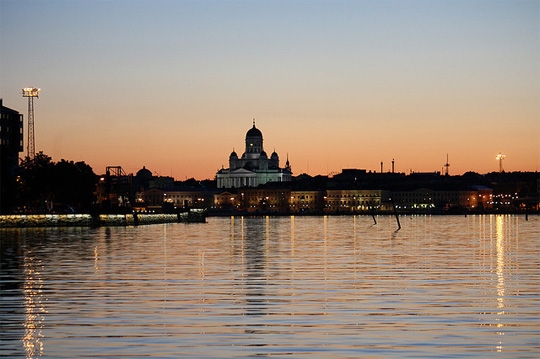
This is what Helsinki looks like at 01:00 on juhannus. Photo: Maanmatonen on Flickr
We've begun a new series of posts that reflect on the HDL Studio experiences from this summer. Check out the first two bits on building the right team and making the most out of a single week. Up next we'll have a post on knowledge transfer, to be followed by further posts on the all the behind the scenes work that goes on to support the studios.
Work continues on many fronts. Amongst them: zeroing in on September, starting a new project related to this website, and continuing to scope out the evolution of HDL.
Goodbye, June!
Posts tagged with "How-To" contain reflections on designing, organizing, and operating the HDL Studios, a series of three collaborative, multi-disciplinary problem solving experiments we held this summer. These posts are meant to be informative for others who may also be exploring ways to put the design process to use in new ways or those who find themselves struggling to work between disciplines or silos.
—
Last time we discussed how to put together a great Studio team. The flip side of assembling a talented group of people is that they tend to be incredibly busy, meaning that we were lucky to get a solid week of their time.
In this short window of time, the studio members had to meet and get to know each other, acclimate to the culture and locality of Finland, soak up the specifics of the Studio challenge, and—oh yeah—they also needed some time to work together towards developing a holistic, integrated framework for thinking about the challenge and then document it in a way that would spur conversation. With only a week to accomplish all of this, we had to make every minute count.

The basic outline of the week starts with stuff HDL arranged ahead of time and ended with a self-directed schedule

The actual schedule for each of the studio weeks was something like this
The general scheme for the Studio week started with Monday and Tuesday full of pre-arranged meetings and visits, trailing off to allow the team to define their own schedule in the second half of the week.
On Sunday we gathered for a very casual, quick dinner in the evening to welcome everyone to Helsinki and give them a chance to get to know one another. This ended early so that everyone could catch up on sleep before the busy week, some guests having traveled from overseas.
Mondays began with an introductory session where Marco shared a bit of material to explain "what success looks like" and give the studio and the studio members had another opportunity to introduce themselves and their thoughts on the challenge as outlined by the challenge briefing.
The primary goal of Mondays, however, was to give the studio a solid overview of the context that they would be working within. This was conveyed through a series of 3 or 4 guest lectures, each followed by a discussion period of about an hour. For example, the education studio had speakers talk about the socioeconomic development of Finland, the Finnish bureaucracy, classroom education and teacher education, and policing and prevention related to at-risk youth.
Tuesday of each studio was then spent in the field, out and about around Finland seeing first hand the reality of the challenge. To continue using the education studio as an example, this included visits to a primary school and a youth culture NGO.
Wednesday and Thursday were left relatively un-scheduled for the studio to self-organize and use as they saw fit. During each of the three studios we found that there were requests for additional meetings, so we were able to quickly arrange additional site visits or bring in more speakers on an as-needed basis. Meanwhile, the bulk of these days were spent in deep discussion and debate as the studio team developed a synthetic and holistic response to the challenge.
The ultimate target for the week was a "final review," a brief presentation and conversation with key stakeholders that occurred at the end of the day on Fridays. To help keep things on track, Marco and I sat with the studios on Friday morning to hear a dry-run and provide some feedback on the clarity of the story.
At 4PM on Friday, a group of 3-5 guests arrived and we pushed the conference table out of the way to make room for a presentation and discussion. Afterwards, we continued the conversation over dinner in the studio space, with the work of the studio's intense week covering the walls.
One week disappears very quickly during such an intense experience, and the teams were all very conscientious people who dedicated the entirety of their mental facilities to the challenge we gave them. As a mental 'steam valve' we set the end of the day at 4PM so that everyone could have a chance to rest or relax before dinner (typically at 7PM).
Dinners were pre-booked for each night of the week with the agreement that studio members could opt-out if they needed to rest. However, the majority of the dinners were with the full studios and this proved to be a very important venue for fleshing out ideas and developing the team's social bond. With only four days to really develop the bulk of the work, the Monday-Thursday meals represent a total of about eight hours of conversation—essentially another full work day.

Our hightech solution to keeping the schedule up to date: a laminated poster and some whiteboard markers. We hung this live version of the schedule in a convenient corner of the studio
We also learned the hard way that it's very difficult to control a schedule that involves tons of moving parts. People change their arrival time, or become unavailable, things run late, etc. For this reason, the printed schedule that we handed out at the beginning of the week was just an overview, and we put up a wall-calendar which was updated as-needed the old fashioned way: with a marker.
Posts tagged with "How-To" contain reflections on designing, organizing, and operating the HDL Studios, a series of three collaborative, multi-disciplinary problem solving experiments we held this summer. These posts are meant to be informative for others who may also be exploring ways to put the design process to use in new ways or those who find themselves struggling to work between disciplines or silos.
This post is borrowed from Week 063's weeknote, which we've updated and expanded upon. Apologies for those who may have already read this entry.
—
One question we often get is "how do you pick the studio teams?" During the HDL Studio on Education someone went so far as to joke that they felt like they were participating in an Agatha Christie novel: a group of people are mysteriously pulled together out of thin air—why are they here and what will they do now? This post attempts to answer the first half of that question.
To begin, it's important to know that as the research for the Challenge Briefings developed, we created expertise profiles for each studio. These were running lists that identified what we consider to be key perspectives for each studio topic. This allowed us to target specific skill-sets and experience profiles.
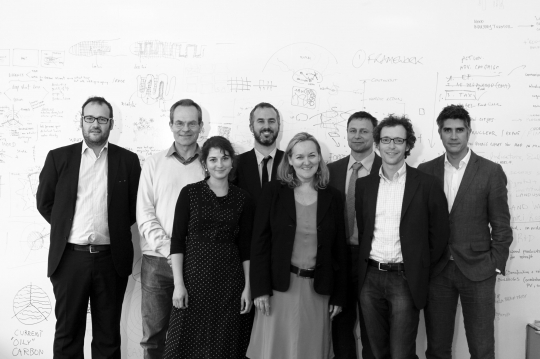
Sustainability, one of three studio teams from the summer of 2010
For instance, in the Studio on Sustainability we knew that building physics, transit, and policy would be essential areas. These are quite predictable. But we also sought some perspectives that might at first be unexpected. The thought behind this is simple: if you only include the regular suspects you will only get regular results. The notion of an "X-factor" can certainly go too far. For instance, although juggling is certainly an unexpected perspective for a conversation about sustainability, it's probably not the most relevant. The X-factor works best when it's someone who has a demonstrated commitment to the studio theme even if their everyday work does not 100% overlap with it.
We wanted the Studio to be as autonomous as possible so that their recommendations would truly be their own. For this reason we decided from the start that Sitra's role would be to support the studio rather than play an active role such as facilitating or otherwise being part of the Studio team.
Here are the basic rules of thumb that we used when thinking about the mix of the team and how to select the right individuals:
- Keep it small: With too few people there's a danger that conversation will not be robust enough, but with too many people in the room it's difficult to have a single conversation. Based on experience, and a bit of advice from Dan Goldin, a team of eight is optimal and we've now seen that it works very well. Some things work in large groups, but strategy sessions are not one of them. Eight is also small enough that you can fit into two cars. Although this seems like a small thing, the logistics required to smoothly pull off an event like HDL Studios are not to be underestimated.
- No room for duplicates: The studio team will be working quickly, which means that the collective expertise and experience in the room is the team's largest asset. Although team members may have some overlaps in their interests, it's best if each member is the master of their own domain and offers serious, focused expertise about their field. Each member becomes a 'representative' of their expertise and no one is redundant.
- Only accept the best: When it comes to selecting individuals, we've gone straight to the top. Across the board, we feel that the studio members we've attracted are either at the top of their respective fields or upcoming talents. High quality input may not quite guarantee high quality output, but it's certainly a prerequisite.
- Flexible expertise: It doesn't matter if you're the top expert on the planet in subject XYZ unless you're able to relate to others and convey your ideas in an open, productive manner. For this reason, we look for people who are at the top of their field, know their material inside and out, but are also naturally curious about the world around them and are able to sociably entertain models that conflict with—or even contradict—their own.
- Be (a bit) local: One of the great strengths of the HDL Studio format is that it offers a very fast and focused infusion of international expertise. But bringing in a wholly international group can lead to fruitless conversations when the cultural context is not understood. We set a rule of thumb for ourselves that two of the studio members would be Finns so there would always be 'cultural ambassadors' in the core team.
- Design is the glue: Each of the studios have two designers who work as facilitators amongst a group of peer-experts. It's their job to ensure that the conversation is balanced and holistic. Only a particular kind of designer will work in this context: they need to be able to apply their training to strategic issues. When recruiting the two designers for each studio we looked for one highly seasoned professional and one who was closer to the beginning of their career.
If these are the rules that guide our choices, one might ask how we first narrow the field. So far, the best indicator we have is that the kinds of people who succeed in collaborations with HDL are those who have significant experience in multiple cultures. Marco likes to use the term Third Culture Kid. This may be "culture" as it's typically defined or it may also refer to different cultures of expertise or work.
If I have the choice between an expert in astrophysics and an expert in astrophysics with a previous background in agriculture, my bet is on the latter. There's something about having lived in multiple cultures that prepares an individual for the kind of lateral thinking that is required in an HDL Studio.
Finally, the mix of the studio in terms of both expertise and personality is important. While one my be able to judge an individual's expertise by broswing a CV and reading some publications, it's very difficult to assess whether an individual will work well as part of a team unless you meet them in person. Sharing a phone call works too, but it's not as effective as having a face to face conversation with someone.
We also relied on our personal networks to recommend people who they thought would be right for this kind of experiment and followed up recommendations with phone conversations or, when possible, in-person visits.
For all of these reasons listed above, we devote a lot of time to sketching out the right mix for a team, courting a qualified pool of invitees, and working to secure their participation. As a reference, the process of defining the HDL Studio teams began eight months before the first studio, with the last three months of that period being the most intense. Without a solid team the entire Studio is moot, so it was worth it invest in taking the necessary time to ensure that the starting point would be strong.









